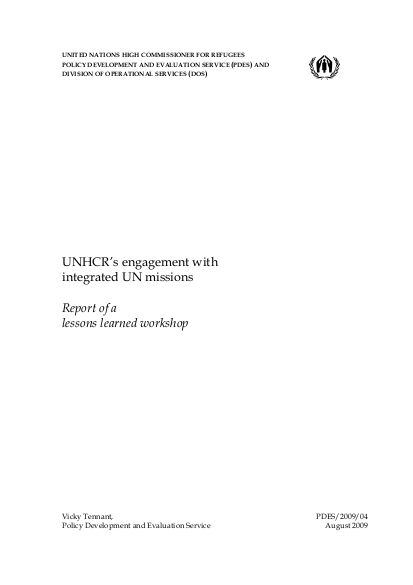
This report summarises the discussions at a workshop held in Geneva on 20 and 21 November 2008. The aim was to capture key lessons from headquarters and field experience in engaging with integrated UN missions, with the aim of defining key objectives to be pursued in UNHCR’s engagement within an integrated UN presence in country operations where UN peacekeeping or political missions are deployed, and informing future policy and operational guidance. Discussions were structured around a draft policy guidance note, which sought to identify eight key policy goals which might be pursued by UNHCR. This covered issues such as the relationship between the integrated approach and UNHCR’s mandate for refugee protection and solutions, and its role in relation to internal displacement; the implications of integration for humanitarian action; the integrated mission planning process (IMPP); security management; security of beneficiaries; return and reintegration; rule of law and reconciliation; mission services and assets; and staff secondments. The key components of the draft policy guidance were broadly endorsed by participants, however it was felt that some proposed goals should be nuanced or expanded. The starting point for the discussions was that integration is now a key element of the operational landscape, and that UNHCR should engage decisively in this process. Significant recent developments include June 2008 Policy Committee decision, which confirmed integration as the ‘guiding principle’ underpinning UN engagement in operations where peacekeeping or political missions are deployed. Participants saw the integrated approach as offering significant opportunities for enhanced delivery of the ‘solutions’ component of UNHCR’s mandate, and linking this to broader conflict resolution and peacebuilding processes. Other opportunities were identified in the potential role of integrated missions in contributing to the protection of civilians, including through support to return and reintegration and in enhancing the security of IDP and refugee camps.
Participants nonetheless highlighted the potential risks of integration in situations where confict is still ongoing or a peace consolidation process has not yet taken root. In such situations too close an alignment between humanitarian agencies and UN political or peacekeeping actors may undermine the perceived neutrality and impartiality of humanitarian action and pose a threat to humanitarian space. In such situations structural integration (locating the Humanitarian Coordinator function within the mission) should be avoided, and the form of integration adopted (if at all) should be minimal. Participants emphasised the need for substantive senior management commitment to strategic engagement with integrated missions at all stages of their development and deployment. It was suggested that as well as developing a clear policy and strategy on engagement within an integrated UN presence, a clear strategy should also be developed for each situation in which integration was tabled, to be jointly pursued by UNHCR staff at country level, in New York, and at Headquarters. Participants also encouraged UNHCR to invest efforts in fostering open and informed attitudes by UNHCR staff to the integrated approach, through education, training and appropriate career development opportunities, including strategic secondments.